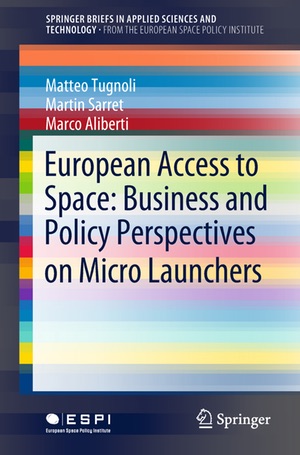Review: European Access to Spaceby Jeff Foust
|
| “This late time-to-market is likely to create additional difficulties in positioning a European solution on a market in which competitors are already positioned and are building on experience, launch heritage and established relationships with customers,” they conclude. |
Europe is no stranger to this interest in small launchers as well. Besides the Vega—a small vehicle when compared to the Ariane 5, but far larger than many smaller launch vehicles under development—there are several initiatives, from the United Kingdom to Spain, to develop such vehicles. But do such vehicles make sense, and if so, what should European governments be doing to encourage their development? Those are issues explored by European Access to Space, a monograph by three researchers at the European Space Policy Institute.
Despite the title, much of the book is a general examination of the small launch vehicle field, including an overview of development efforts worldwide (and an aside to describe NewSpace entrepreneurial space efforts) and the growth in smallsats that has stimulated much of the interest in small launch vehicles. One chapter is devoted to a general market assessment for small launchers, examining both potential markets and competition from secondary payload accommodations and dedicated launches of large numbers of smallsats on larger vehicles.
Not surprisingly, the book doesn’t provide specific conclusions on the size of the market given questions about demand from megaconstellations or interest from the scientific community or militaries. “[T]he market for micro launchers remains as of yet unclear,” they write.
An unclear market doesn’t mean that such vehicles shouldn’t be developed. However, they warn that European small launchers are unlikely to enter service before 2020, after American and other vehicles enter the commercial market. “This late time-to-market is likely to create additional difficulties in positioning a European solution on a market in which competitors are already positioned and are building on experience, launch heritage and established relationships with customers,” they conclude.
They offer several recommendations for ESA, the European Union, and others in Europe to follow to help improve the prospects for European launchers. They include stimulating demand for those vehicles through support for smallsat initiatives in Europe, providing access to infrastructure like launch sites, funding technology development, and establishing “financing and regulatory mechanisms” for such vehicles, areas which they argue Europe significant lags the US.
Will those be sufficient to keep European small launch vehicle efforts competitive in a global market? It will depend on, among other things, the effectiveness of those vehicles versus American and other counterparts in terms of technical performance, reliability, and price. However, there’s still significant skepticism that there will be that much demand for small launch vehicles, particularly as rideshare options grow. The recommendations in the book—intended primarily for those deeply involved in the field, given its price—may be necessary conditions to enabling a small launch vehicle industry to thrive in Europe, but alone they may not be sufficient.
Note: we are temporarily moderating all comments subcommitted to deal with a surge in spam.
